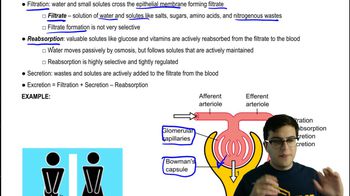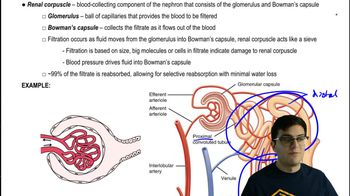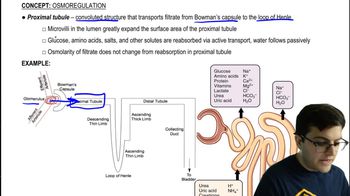Table of contents
- 1. Introduction to Biology2h 40m
- 2. Chemistry3h 40m
- 3. Water1h 26m
- 4. Biomolecules2h 23m
- 5. Cell Components2h 26m
- 6. The Membrane2h 31m
- 7. Energy and Metabolism2h 0m
- 8. Respiration2h 40m
- 9. Photosynthesis2h 49m
- 10. Cell Signaling59m
- 11. Cell Division2h 47m
- 12. Meiosis2h 0m
- 13. Mendelian Genetics4h 41m
- Introduction to Mendel's Experiments7m
- Genotype vs. Phenotype17m
- Punnett Squares13m
- Mendel's Experiments26m
- Mendel's Laws18m
- Monohybrid Crosses16m
- Test Crosses14m
- Dihybrid Crosses20m
- Punnett Square Probability26m
- Incomplete Dominance vs. Codominance20m
- Epistasis7m
- Non-Mendelian Genetics12m
- Pedigrees6m
- Autosomal Inheritance21m
- Sex-Linked Inheritance43m
- X-Inactivation9m
- 14. DNA Synthesis2h 27m
- 15. Gene Expression3h 20m
- 16. Regulation of Expression3h 31m
- Introduction to Regulation of Gene Expression13m
- Prokaryotic Gene Regulation via Operons27m
- The Lac Operon21m
- Glucose's Impact on Lac Operon25m
- The Trp Operon20m
- Review of the Lac Operon & Trp Operon11m
- Introduction to Eukaryotic Gene Regulation9m
- Eukaryotic Chromatin Modifications16m
- Eukaryotic Transcriptional Control22m
- Eukaryotic Post-Transcriptional Regulation28m
- Eukaryotic Post-Translational Regulation13m
- 17. Viruses37m
- 18. Biotechnology2h 58m
- 19. Genomics17m
- 20. Development1h 5m
- 21. Evolution3h 1m
- 22. Evolution of Populations3h 52m
- 23. Speciation1h 37m
- 24. History of Life on Earth2h 6m
- 25. Phylogeny2h 31m
- 26. Prokaryotes4h 59m
- 27. Protists1h 12m
- 28. Plants1h 22m
- 29. Fungi36m
- 30. Overview of Animals34m
- 31. Invertebrates1h 2m
- 32. Vertebrates50m
- 33. Plant Anatomy1h 3m
- 34. Vascular Plant Transport2m
- 35. Soil37m
- 36. Plant Reproduction47m
- 37. Plant Sensation and Response1h 9m
- 38. Animal Form and Function1h 19m
- 39. Digestive System10m
- 40. Circulatory System1h 57m
- 41. Immune System1h 12m
- 42. Osmoregulation and Excretion50m
- 43. Endocrine System4m
- 44. Animal Reproduction2m
- 45. Nervous System55m
- 46. Sensory Systems46m
- 47. Muscle Systems23m
- 48. Ecology3h 11m
- Introduction to Ecology20m
- Biogeography14m
- Earth's Climate Patterns50m
- Introduction to Terrestrial Biomes10m
- Terrestrial Biomes: Near Equator13m
- Terrestrial Biomes: Temperate Regions10m
- Terrestrial Biomes: Northern Regions15m
- Introduction to Aquatic Biomes27m
- Freshwater Aquatic Biomes14m
- Marine Aquatic Biomes13m
- 49. Animal Behavior28m
- 50. Population Ecology3h 41m
- Introduction to Population Ecology28m
- Population Sampling Methods23m
- Life History12m
- Population Demography17m
- Factors Limiting Population Growth14m
- Introduction to Population Growth Models22m
- Linear Population Growth6m
- Exponential Population Growth29m
- Logistic Population Growth32m
- r/K Selection10m
- The Human Population22m
- 51. Community Ecology2h 46m
- Introduction to Community Ecology2m
- Introduction to Community Interactions9m
- Community Interactions: Competition (-/-)38m
- Community Interactions: Exploitation (+/-)23m
- Community Interactions: Mutualism (+/+) & Commensalism (+/0)9m
- Community Structure35m
- Community Dynamics26m
- Geographic Impact on Communities21m
- 52. Ecosystems2h 36m
- 53. Conservation Biology24m
42. Osmoregulation and Excretion
Osmoregulation and Excretion
Problem 2a
Textbook Question
Textbook QuestionWhich process in the nephron is least selective? a. filtration b. reabsorption c. active transport d. secretion
 Verified step by step guidance
Verified step by step guidance1
Step 1: Understand the question. The question is asking which process in the nephron is least selective. The nephron is the functional unit of the kidney, responsible for filtering blood and forming urine. The processes involved include filtration, reabsorption, active transport, and secretion.
Step 2: Understand the processes. Filtration is the process where blood pressure forces water and other small molecules through a selectively permeable membrane. Reabsorption is the process where certain molecules and ions are reabsorbed back into the blood. Active transport is the process where molecules move against a concentration gradient, requiring energy. Secretion is the process where substances are transported from blood into the filtrate.
Step 3: Evaluate the selectivity of each process. Filtration is not very selective, as it allows all small molecules to pass through. Reabsorption is selective, as only certain molecules are reabsorbed. Active transport is also selective, as it requires specific carrier proteins. Secretion is selective, as it involves the transport of specific substances.
Step 4: Compare the selectivity of the processes. Among the four processes, filtration is the least selective because it allows all small molecules to pass through, regardless of their type.
Step 5: Choose the correct answer. Therefore, the answer is (a) filtration.
Recommended similar problem, with video answer:
 Verified Solution
Verified SolutionThis video solution was recommended by our tutors as helpful for the problem above
Video duration:
45sPlay a video:
Was this helpful?
Key Concepts
Here are the essential concepts you must grasp in order to answer the question correctly.
Filtration
Filtration is the first step in urine formation that occurs in the glomerulus of the nephron. During this process, blood pressure forces water and small solutes, such as ions and glucose, through the glomerular membrane into the Bowman's capsule. This process is relatively non-selective, allowing a wide range of substances to pass while retaining larger molecules like proteins and blood cells.
Recommended video:
Guided course

Filtration, Reabsorption, and Excretion
Reabsorption
Reabsorption is the process by which the nephron selectively reclaims water and essential solutes from the filtrate back into the bloodstream. This occurs primarily in the proximal convoluted tubule and loop of Henle, where specific transport mechanisms ensure that vital nutrients and a significant amount of water are conserved, making it a highly selective process.
Recommended video:
Guided course

Filtration, Reabsorption, and Excretion
Active Transport
Active transport is a cellular process that moves substances against their concentration gradient, requiring energy in the form of ATP. In the nephron, this mechanism is crucial for reabsorbing ions like sodium and potassium, as well as other molecules, ensuring that essential nutrients are retained while waste products are excreted. This process is highly selective, as it targets specific molecules for transport.
Recommended video:
Guided course

Active Transport

 7:16m
7:16mWatch next
Master Osmoregulation and Nitrogenous Waste with a bite sized video explanation from Jason Amores Sumpter
Start learningRelated Videos
Related Practice


































































